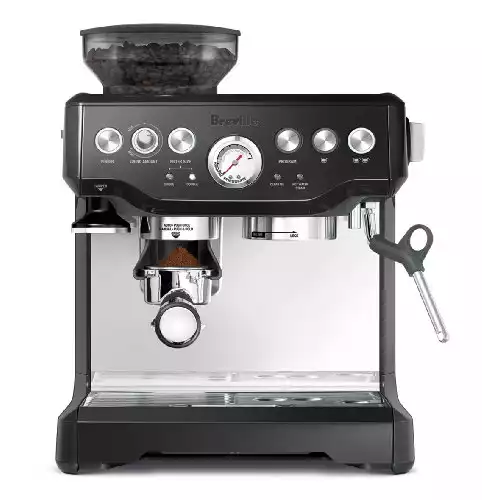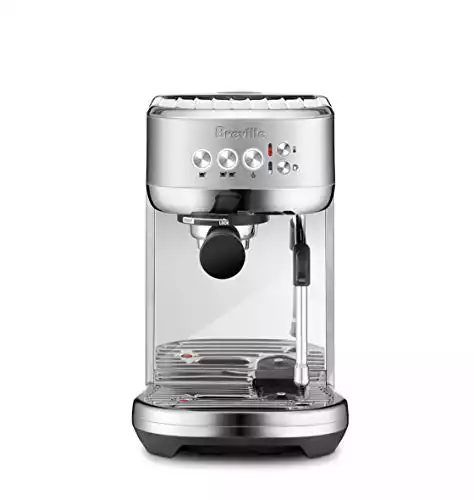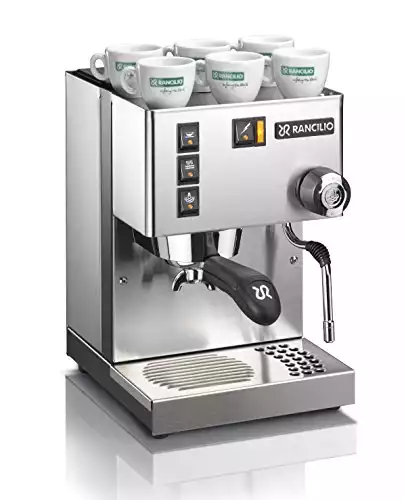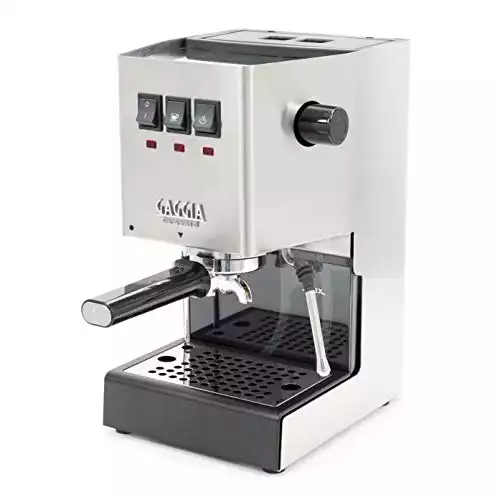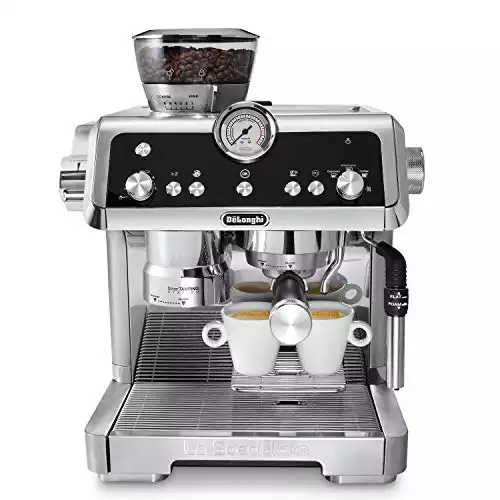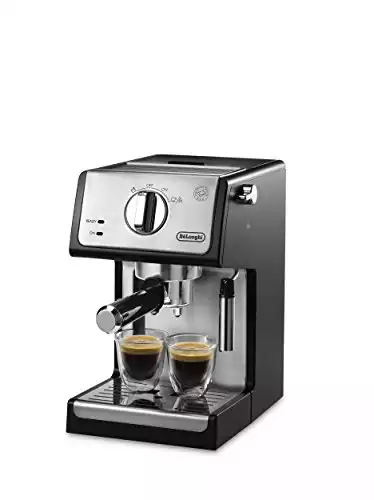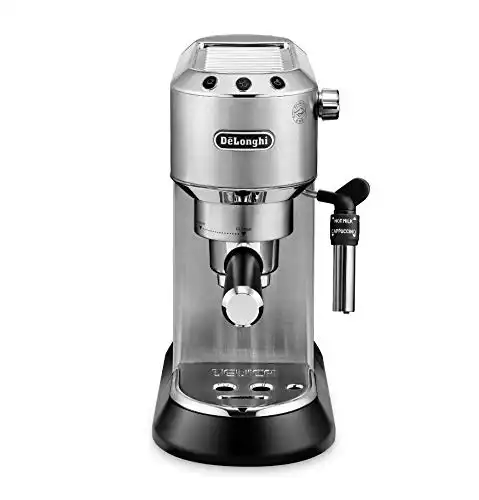Best Semi-Automatic Espresso Machine 2024
When it comes to choosing an espresso maker, you’ll likely feel bombarded by many different brands, and the choices can be overwhelming.
Nonetheless, the best semi auto espresso machines mostly have the same level of specs. There’s always some variations depending on what you consider ‘best,’ especially if you enjoy milky coffee!
Below we detail 7 of our favorites, but if you’re in a hurry, here’s our top picks for the best semi automatic espresso machine in 2024.
Top Semi Automatic Espresso Makers Summary
Picking The Best Semi-Automatic Espresso Machine
How can you pick the best semi-automatic espresso machine?
There’s a lot to take into account, including your budget, what type of boiler you want, if you need a built-in grinder, how often you’ll use it, and how much control you want to have over every variable.
Let’s go through each point so you can come to the best decisions for you.
Budget
High-quality espresso machines have high price tags. The price tags can go above $1,000 for regular home models, or into the thousands for a true luxury machine. Semi-automatic machines tend to have price tags in a more modest range.
The higher the price range you look at, the more durable the machine will be.
Obviously, a solid machine from a reputable company that uses stainless-steel parts and a reliable built-in coffee grinder is going to be more expensive than a cheap plastic machine that is more along the lines of a disposable coffee maker. And you’ll taste the results as you get a quality shot time and time again.
Deciding how much to pay for an espresso machine requires balanced judgment. While a specialty cafe has espresso machines that cost as much as a used car, they also have trained baristas using those machines who produce hundreds of shots a day.
Most home brewers don’t need to go to that high of a price range to get a reliable machine.
Boiler Type
Although this can sound complex, the boiler type refers to how the machine heats up the water. Water temperature for brewing espresso is a lot lower than the water temperature you need to steam milk.
So how does an espresso machine provide both those temperatures?
It comes down to two basic options: a single or double boiler. A single boiler lets you heat up the water for both functions, but not at the same time.
After brewing your espresso, you’ll have to wait while it heats up for the next task, which is steaming the milk.
A dual heating system gives you two boilers that let you heat water for brewing and to steam your milk at the same time.
That’s a huge benefit. But the benefit comes with a higher price tag, since two boilers are more expensive. You can find middle ground with a heat exchange boiler, where one boiler provides water for both needs.
Need a Built-In Grinder?
If you don’t already have a coffee grinder, you need to weigh whether you want to buy a machine with a built-in coffee grinder incorporated into the setup.
Your choice of coffee grinders could be the most important step you take to ensure you get good-tasting espresso.
For brewing espresso you need a very fine grind, which a cheap blade grinder can’t produce. That’s why the best semi-automatic espresso machines come equipped with built-in burr grinders.
The fact that many high-quality espresso makers come with a built-in grinder is convenient, since you’ll be taking up less space on your kitchen counter or your coffee station.
On the other hand, you might want a separate coffee grinder that makes it easier to do maintenance and repairs.
Frequency of Use
How often will you use your espresso machine?
Since there’s quite an investment involved, as well as some maintenance, an espresso machine might not be the best purchase for an occasional lazy Sunday morning cappuccino. You don’t want it to become a fancy – and expensive – decoration on your kitchen counter.
Another factor to consider is how much time you have each day to make espressos. If you need a shot in a minute as you’re dashing out the door, a semi-automatic espresso machine won’t be the best fit for you. You’ll need to look at an espresso machine that’s fully automatic.
Simplicity VS Control
While no espresso machine will be as easy to use as a drip coffee maker, the complexity of the brewing process will depend on the specific machine.
When buying an espresso machine you need to choose between simplicity of functions and how much control you have over the variables.
Generally, the simpler the machine is to use, the less control you have. There are functions that you can preset and timers, but they are generally not all that programmable and produce the beverages automatically.
A super-automatic espresso machine will, at the press of a button, present you with finished drinks. You can think of some of them as a cappuccino machine. They have an automatic milk frother and create delicious lattes with good coffee flavor. They’re super easy to use, but there’s no control at all.
On the other hand, an automatic espresso machine will require you to work more to grind beans, brew the coffee, steam the milk, and pull the espresso shot. Lots of control, but as you can see, quite a bit of work.
A semi-automatic espresso maker falls somewhere in between the two and will do some of the work for you.
Now let’s get into some semi-automatic espresso machine reviews so you can apply the knowledge you just gained to understand the best espresso machines on the market.
Best Semi-automatic Espresso Machine 2022
1. Breville BES870BSXL The Barista Express Coffee Machine
The Breville Barista Express is a solid machine at a reasonable price point. The first Barista Express came out over a decade ago and has been one of the most popular choices for a semi-automatic espresso machine.
Its many features and attractive design will change your kitchen into a specialty cafeas you produce tasty espresso beverages.
PROS (+)
- Excellent for serious beginners
- Thermocoil boiler heats up fast
- Manual steam wand
CONS (-)
- The single boiler is slower between brewing and steaming
- Not the highest level of control
This semi-automatic espresso machine has a steam wand, and the 15 bar pump ensures enough brewing power. You can regulate pressure with the pressure gauge.
The built-in conical stainless steel burr grinder is a plus on several points. A built-in grinder saves space on your counter, controls your dose, and it grinds right into your portafilter so you avoid messy stray grinds on the counter.
While the price tag on these types of coffee makers is a bit higher than some of the other espresso machines on this list, you get more automated features. Automatic dosing gives you the perfect amount every time. There’s a pre-infusion function and PID-regulated digital temperature control.
Good for beginners, this mid-size espresso machine warms up in just one minute due to the Thermocoil boiler. You can increase or decrease brew temperature by a few degrees.
You can program single or double shots. It comes with four 53 mm portafilter baskets (double and single, pressurized and non-pressurized).There’s also a dedicated hot water dispenser for making americanos.
This machine comes with a stainless steel steam wand that swivels easily. With this kind of steam wand, you can create just the steamed milk texture you need. With a single boiler like in this brewer, you do have to wait after brewing to steam the milk.
Who should avoid the Breville Barista Express?
If you want a completely automated brewing process, the Barista Express won’t give you that. This machine gives you a hands-on brewing process that makes it easy for you to learn to make the best espressos.
2. Breville BES500BSS Bambino Plus Espresso Machine
The Bambino Plus is a great beginner espresso machine. At a reasonable price point, this tiny machine fits under most kitchen cabinets with perfect flavor.
One of the smallest models on the market, it’s great for those starting out with espresso makers or if your counter space is limited.
PROS (+)
- Ultra-compact
- Heats up fast
- Easy to use
CONS (-)
- No hot water dispenser
- Lacks customization
Simplicity is key with this machine. It heats up fast, within seconds. You can preset shot times for single and double shots. And the machine allows you to set brew times and adjust the water temperature.
Pressurized brew baskets make it easy to get the perfect shot. If you don’t yet have a coffee grinder capable of espresso grind, this kind of basket allows you to produce good shots with pre-ground espresso beans. You can also use non-pressurized baskets. The machine comes with both single and double pressurized baskets.
An automatic steam wand lets you steam milk at just the right temperature and get microfoam that has a rich texture that contributes to delicious lattes.
Since this is automatic, you don’t even have to know about milk steaming and frothing to get good results. Just hit a button and get your milk steamed.
The stainless steel milk jug needs a higher volume of liquid to work properly, so if you’re making a latte for just one person you might find you’re wasting a lot of milk. There’s no dedicated hot water dispenser for brewing tea or making an americano.
Who should avoid it?
These simple coffee makers offer ease of use at the expense of customization. This machine will give you a good solid espresso experience without much room to grow.
3. Rancilio Silvia Espresso Maker
The Rancilio Silvia espresso machine is a traditional machine that has been around since the 1990s. Trust the Rancilio brand to create a solid, dependable machine.
PROS (+)
- High brewing control
- Professional quality
- Durable
CONS (-)
- Higher price range
- Can be difficult for beginners
This single boiler espresso maker in stainless steel casing is similar in quality to the commercial line. That explains the higher price tag.
But a higher price means you gain in durability and reliability. This machine is ideal for intermediate home baristas who want a completely manual espresso experience in a mid-size machine.
The boxy, almost vintage, design will remind you of a cafe machine. The solid build and stainless steel construction mean the machine will last. It gives you a very manual experience, is highly versatile, and easy to modify.
The 3-way solenoid valve is a big plus. It de-pressurizes the group head, so you can pull a shot and immediately remove the portafilter. That will save you time if you’ll be making espresso shots back-to-back.
When you look at the durability and high-quality parts of these coffee makers, it’s understandable why they have a higher price tag. This is a machine that lasts for the test of time.
The Rancilio Silvia is perfect for you if you’re looking for a café-type experience at home and want a dependable, if not attractive, machine.
Who should avoid it?
If you are a brewing newbie, this is likely not the machine for you!
4. Gaggia Classic Pro Espresso Machine
The Gaggia Classic has been around for decades. It’s gone through upgrades and changes, but it is still a minimalist and easy-to-use espresso machine.
PROS (+)
- Easy to use
- Excellent steam wand
- Reliable
CONS (-)
- Older build and design miss out on new technology
- No built-in grinder
The single boiler heats up fast and does provide a relatively consistent brew temperature. With a stainless steel build, you’ll get quality at a great price. This machine only brews coffee. So it’s not a cappuccino machine that produces your beverage at the press of a button.
The commercial-grade steam wand makes excellent milk foam for latte art. It comes with a two-hole steam wand, which gives you greater control over steaming milk, a step up from a one-hold wand.
Since the 58 mm filter basket is a standard size, it’s easy to replace, get an extra one, or figure out ratios from standard recipes.
It has a non-pressurized brew basket, but you can use it with a pressurized brew basket if you decide to use coffee that’s pre-ground. It has a solenoid valve to help with de-pressurizing.
It does not have a built-in grinder for coffee beans. That can be a plus or a negative. It’s easier to do maintenance on a separate dedicated grinder. But on the negative side, you need to buy a grinder for your coffee beans.
Who will love this espresso maker?
If you want a dependable manual espresso machine that produces coffee-shop-level shots at a lower cost than many machines, this may be the best for you. It’s great for beginners who want a manual experience, since there’s no programming.
Who should avoid it?
If you want new technologies in temperature control, better pressure control, or the benefits of a double boiler.
5. Delonghi La Specialista
The Delonghi La Specialista is a highly attractive espresso machine. It gives you the look of a professional espresso machine while still being compact enough for most home kitchens.
PROS (+)
- Gorgeous design
- Fast and automatic
- Comes with a built-in burr grinder
CONS (-)
- Expensive
- Features might seem complex to some users
This espresso machine is customizable, convenient, and fast. As an all-in-one machine, it also leaves out the guesswork.
Of course, it doesn’t come with with a budget price tag. The highest on this list, in fact. But when you take a look at all the features, you may feel that it’s worth it.
This espresso machine is great for beginners. With the built-in grinder you can control coffee dosing. You can automatically adjust shot times and make any espresso drink. You can select espresso, americano or lungo options, and it’s easy to steam milk. Choose from manual foam or automatic steaming.
The dual heating element heats up fast, in less than 30 seconds. It provides the ideal temperature for brewing espresso and steaming milk at the same time, with no waiting between tasks.
This machine comes with a built-in burr grinder that allows you to control grind consistency and dose automatically. The grind time is also adjustable, while the built-in tamper provides consistent puck pressure.
Not the smallest machine, it will still fit on many kitchen counters. As for durability, the boiler is stainless steel lined and the machine has a stainless steel case. This coffee maker is not pod friendly, and the portafilter size is a bit smaller than standard, at 51 mm.
This is an excellent machine for beginners who want an attractive, durable machine that is highly automated. Those who want a budget-friendly machine that’s more manual might be disappointed.
6. De’Longhi ECP3420
The De’Longhi ECP3420 is a low-cost espresso mac hine that’s ideal to start with if you’re getting your feet wet in the world of espresso.
PROS (+)
- Inexpensive
- Good starter machine
- Pressurized portafilter lets you use pre-ground coffee
CONS (-)
- Lacks features
- Is not durable
With its pressurized portafilter you don’t need to have coffee grinders. This type of portafilter lets you use pre-ground coffee and still gives you enough pressure to create rich crema. In fact, you get three filter baskets with this machine, so you can make single or double espressos or brew pods.
The steam wand is easy to use, with what De’Longhi calls their cappuccino system. It’s a manual milk frother that allows you to control the milk texture.
This coffee machine is good for people who want an entry-level cappuccino machine that does the basics and will accept coffee pods.
If you want a durable machine that will be around for years that you can customize, you might want to look at other machines on this list.
7. De’Longhi Dedica EC685M
The De’Longhi Dedica 685M is an adorable machine reminiscent of early espresso makers. At under 7 inches wide, this narrow, tall machine takes up little counter space.
PROS (+)
- Reasonably priced
- Attractive design
- Heats up fast
CONS (-)
- Machine clogs with extra fine grinds
- Inconsistent brewing temperature
This entry-level machine has a stainless steel body and Thermo block technology that heats up quickly, in less than a minute. It comes with 15 bar pressure that you can adjust.
This is a single boiler machine, so there’s no brewing and steaming at the same time. The temperature control is adjustable but not completely reliable, and you’ll find that at times it’s too low or high.
The front of the machine is attractively minimalist, with buttons for single or double shot brewing and one for steam. Simple to operate, just push a button for a single or double shot and it automatically pulls shots.
There’s lots of programmability with this machine so you can easily adjust for your tastes. You can program a longer or shorter brew time. It has an ESE pod basket to brew pods.
You can adjust the standby mode, and when it comes time for cleaning you can count on an automatic descaling mode. This is not a professional machine and you might find that it has a tough time with lighter roasts.
The steam wand can froth milk fast and is an adequate distance from the machine so it’s not hard to steam milk in any container you’d prefer.
When the drip tray is full, a float signals it’s time to empty the drip tray. There’s an area on top to store or slightly warm cups.
Great for beginners, this espresso maker is priced to help you get going in the world of espresso. This may not be a machine to grow with due to a lack of features and customizability.
Semi-Automatic Espresso Machine Buyers Guide
Espresso Machine Brands
Breville
Founded in Sydney in 1932, this Australian brand produces many types of home and kitchen appliances. Breville consistently gets top ratings for coffee appliances for home use.
They also have a range of coffee-related products that you can choose from. Their machines are easy to use and perform well. For instance, the Barista Express is a solid machine at a reasonable price point. The Bambino Plus is packed with features and great for those starting out with espresso makers.
Gaggia
Often rated as among the best espresso machines on the market, these Italy-designed and manufactured machines are for professional as well as home use.
One of their popular high-quality espresso machines is the Gaggia Classic Pro, which has been around for decades.
Back in the 1930s Achille Gaggia invented the Lampo system of espresso machines that helped baristas get better control over water temperature. He overcame the problem of pressure with a lever machine.
From there the term pulling a shot was created, as baristas had to pull the lever down to create the rich espresso. It also developed crema, which is the foam that sits on top of a freshly pulled espresso.
Rancilio
Founded in 1927, this Italian coffee brand is an authority in the field. Primarily focused on producing espresso machines for professional use, you’ll see their professional machines in many coffee shops.
But some of their home machines are the most popular for serious home baristas. They are durable coffee makers that are easy to maintain.
The headquarters are still in Italy, though they operate in over 100 countries. You’ll see Rancilio coffee machines at specialty coffee competitions around the world.
It’s easy to start out with a Rancilio home machine. The Rancilio Silvia espresso machine is a solid, dependable machine that has been around for decades and is a durable, reliable machine for serious home baristas.
De’Longhi
An appliance company based in Italy, De’Longhi was founded in 1902. They still have their headquarters in the town where they started out, Treviso, Italy.
And there’s still a De’Longhi at the head of the company. They produce durable machines at accessible prices, which is why you’ve seen the name several times in this post.
They make more than just coffee makers, but when they apply their design know-how and innovation to making espresso, you can trust the results.
The beautiful design, user-friendly processes, and good price points make these products a hit. They are one of the brands that also manufacture Nespresso coffee makers.
You’ll see numerous De’Longhi machines on this list because the machines are inexpensive, beautifully designed, and work well.
How To Use A Semi-Automatic Espresso Machine
No matter which semi-automatic machine you buy, there are some basic steps you must follow to get a good brew. Let’s go over three of those steps.
Right Grind
This is one of the most essential factors to getting a good brew. Grind size is key in producing espresso shots that fill you with satisfaction. That’s why it’s essential to have a coffee grinder.
While you need to start with the basic step of using a fine grind, there are a lot more factors involved.
What’s the best fine grind for your machine?
Every espresso machine is different, and it will take you some time to find the perfect grind. You can start with a fine grind setting and then experiment with going even finer or opt for a slightly coarser grind.
And just when you thought you had it figured out…you switch to another brand of coffee. And you have to calibrate the espresso machine again. But don’t worry – once you’re used to doing it, the process will be fast.
Tamp
Tamping refers to compressing, or compacting, the coffee grinds in a portafilter. Many machines often come with a tamper, or you can buy any that suit your fancy.
Tampers these days come in all shapes and colors, and they work in different ways. But the most important consideration is getting the right tamp pressure. Why is the right tamp pressure important?
When you tamp the coffee grounds in the portafilter, you want to make sure they are evenly dispersed and compacted to the right degree.
If you compact too much, the water can’t make its way through the coffee grounds and you’ll wind up with a bitter, overextracted espresso. If you don’t tamp enough, the water will pass through the coffee grounds too fast and you’ll have an underextracted, sour brew.
When tamping, you want to provide even pressure so that the bed of coffee grinds are even. Keep in mind these factors:
- Dose – use a fine grind and the proper weight for your shot
- Level – level properly so that the bed is even
- Apply even, balanced pressure
Pull The Shot
Once the portafilter is in place, the time has come to pull the shot. Depending on your espresso maker, perhaps you’ve already heated up the espresso machine.
This can take as much as 10 minutes and is essential to getting a good brew. Some semi-automatic espresso machines may have temperature control so you don’t have to give this a second thought.
Of course, make sure there’s enough water in the water tank of your espresso machine. Heat up the group head by pressing the brew button before the portafilter is in place.
This purges the group head and allows you to work out the optimal temperature you want to reach. Purge for just 5 seconds. Then move the portafilter into place.
Pull the shot for the desired time, then switch the brew button off. It might take a few tries to get the right extraction time, but it’s a fun process that involves tasting many espressos.
The Benefits of a Semi Automatic Espresso Machine
Using a semi-automatic machine has a lot of benefits. This type of espresso machine is easier to use than completely manual machines.
But it’s a type of espresso maker that will still give you enough control over your shots that you can get just the drink you’re aiming for.
This type of espresso maker is also vital in the education process. You can really understand why your espresso shot tastes the way it does. You can learn – and apply – the science behind coffee. You will see how minimal variables create huge changes in the shot.
You’ll really come to understand coffee and the coffee bean, as well as how temperature, time, and pressure act on the coffee grounds. It’s a fascinating process. If you yearn to control every variable in the coffee-making process, you’ll fall in love with semi-automatic espresso machines.
Semi-automatic vs fully automatic espresso machines
If you’ve been reading through this post and feel like a headache is coming on because of all the variables you have to keep track of, perhaps semi-automatic espresso machines aren’t for you. The best semi-automatic espresso machines require more hands-on work to get the perfect espresso.
You have to grind your coffee beans, set the proper temperature, dose (weigh out) the coffee grinds, tamp them, and then finally pull the shot while keeping an eye on pressure.
If that’s too much work for your tastes, fully automatic machines take the guesswork out of all the aspects we’ve mentioned.
All you have to do is make sure the espresso maker has enough coffee beans, water, and milk (if using). Then you just press the button and let the fully automatic machine do its job.
You can get very good coffee from a fully automatic espresso machine – you just won’t have control over each step.
The Final Verdict: Best Semi Auto Espresso Maker
The Breville Barista Express is my top pick. It’s a powerful, reliable, and precise espresso maker that creates excellent espresso beverages.
You can adjust all the variables of coffee brewing with the Barista Express, from pre-infusion all the way to finishing off your espresso shots with milk foam.
When it comes to size, you can’t beat the Breville Bambino Plus Espresso Machine. It’s a tiny yet powerful espresso maker that will deliver the tasty espresso shots and coffee flavor you want.
If you’re looking for an inexpensive way to start making espresso shots at home, the De’Longhi EC680M semi-automatic machine is a good starting point. This entry-level machine will give you satisfying results without breaking the bank.
Frequently Asked Questions
Is 15 bars of pressure enough for espresso?
To brew a delicious espresso, just 9 bars of pressure are needed.
Although some semi-automatic espresso machines may boast of having 15 bars of pressure, espresso machines should be regulated to provide just 9 or 10 bars of pressure while brewing.
In fact, it’s not a good idea to brew espresso at too high of a temperature, since it will take a toll on the machine.
Does Starbucks use automatic machines?
Starbucks used to use La Marzocco brand machines, but now they use super-automatic machines that are made exclusively for the brand and include built-in grinders.
The price hovers between $15,000 and 17,000, so Starbucks espresso machines aren’t for home use.

